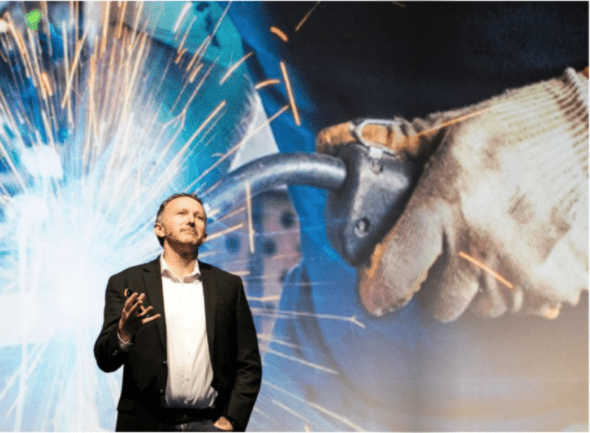Pictured: International entrepreneur and businessman Norman Crowley
International entrepreneur and businessman Norman Crowley has founded multiple businesses including Crowley Carbon, Trinity Commerce – one of the first eCommerce services companies in the world, The Cloud – Europe’s largest WIFI operator and Inspired Gaming Group – the world’s largest company in the server based gaming domain. In this thought-leadership piece, he advocates for clever optimism about our future.
Note: This piece was originally published in Business & Finance magazine, vol. 58, no. 2, available to read, with compliments, here.
Imagine a world where you don’t need to stock up on Vicks VapoRub, Strepsils and Lemsip after catching a common cold. A cure can be “printed” and shipped to you overnight, fixing your sniffles and cough within a matter of hours. This world is not in the distant future, it is 2030.
When you ask people what they think our lives will look like in 2030 and beyond, you get vastly different answers. Numerous articles and reports would have you believe we will be living in a dystopian wasteland of rising sea levels, rolling pandemics and smog covered slum cities. Fear sells very well.
Documentaries such as “The social dilemma” would seem to predict that our young people will end up as thick zombies with no social skills. The recent documentary, “Seaspiracy” paints a picture of a world with dead oceans and a starving population. I think it’s fair to say that this is the most common vision of the future that our children are tuning into.
There is another version of our future for 2030 and beyond. It is a world where energy and transport are carbon negative and free. Where food is carbon neutral and 95% cheaper than it is today. Where education is not only free but also taught by the best teachers in every subject. And where cures for medical ailments can be 3D printed.
I’m sure you are reading this and thinking that I need to get back to the real world. Let me try and explain my ravings.
I have been following a think-tank in the UK, called RethinkX for the last 15 years. They have been conducting in-depth research on many trends to do with our future. Many have said that their claims are fanciful and optimistic. However, if you had followed their investment advice in 2005 and invested €1,000 per year in each of their recommendations, your investment would now be worth a staggering €250,000. Fanciful maybe but also very profitable.
Low cost or free energy, food, transport, education and medicine by 2030 or 2035 compared to a dystopian wasteland of phone addicted zombies? I know which one I choose to believe in.
So, what do these clever optimists have to say about 2030? Due to dramatic price reductions in SWB (Solar, Wind and Batteries), energy will drop in price by more than 90%. It will also become abundant and carbon free. Fanciful? During lock down, some of our largest industrial clients in the US and Brazil saw their energy costs drop by as much as 50% with increased use of wind and hydro power. For a moment in time in mid 2020, oil prices went negative.
With the development of electric vehicles and longer range batteries, vehicles will drive us to our meetings and parties and with the speed of development of autonomous technologies, the cost of these journeys will drop by 95%. In discussing all of these predictions with people, we find that an autonomous vehicle future is the one that people most struggle with. The general view in Ireland is that this autonomous future might be fine in LA but not in rural Ireland. It may then surprise you to know that on a recent trip to Cork, on a rainy Wednesday evening, one of our vehicles happily drove from Enniskerry to the Dunkettle roundabout in Cork, without any intervention from me. It finally got confused and handed back control but then Cork can be a confusing place for many.
That’s all well and good, I hear you say but where is this carbon neutral 95% cheaper food going to come from. Depending on which report you read, between 19% and 30% of our global warming problem comes from the production of meat. In order to feed our growing population we will need seven planet earths worth of water and soil by 2050. Relying on the entire population rushing towards veganism is not a viable option.
Imagine if you could take some animal cells, add some green energy and some sugar and create a burger in a day or two. No slurry, no animal suffering, no antibiotic resistance… just clean meat. Sounds like fantasy however cellular agriculture or precision fermentation is exactly this technology.
If this sounds far too fanciful then take a look at Solar foods in Finland. They are currently building their first large scale plant. Using these technologies they are creating Solein, a food product similar in nutritional value to dairy protein, out of thin air. The system harvests microbes from the air and converts them to food. Food from thin air? Welcome to the future.
In Ireland we are all excited to get our vaccine jab over the next few months. What we may have missed is that the development of MRNA technology will open up the ability to develop treatments for our most serious diseases and our most mundane. The everyday cough and sneeze could finally be conquered.
Finally, one of the biggest changes that we have seen with the global pandemic is the rise and rise of e-learning. While most of us haven’t enjoyed having our kids under our feet all day, it has been amazing to see how kids and adults alike are choosing to learn now. We don’t have to worry about whether our kids’ maths teacher is up to scratch, we can simply point them to Mr. Tobin’s maths on YouTube and learn from one of the best maths teachers in the country. When it comes to learning, the last 12 months have changed everything.
Low cost or free energy, food, transport, education and medicine by 2030 or 2035 compared to a dystopian wasteland of phone addicted zombies? I know which one I choose to believe in.

